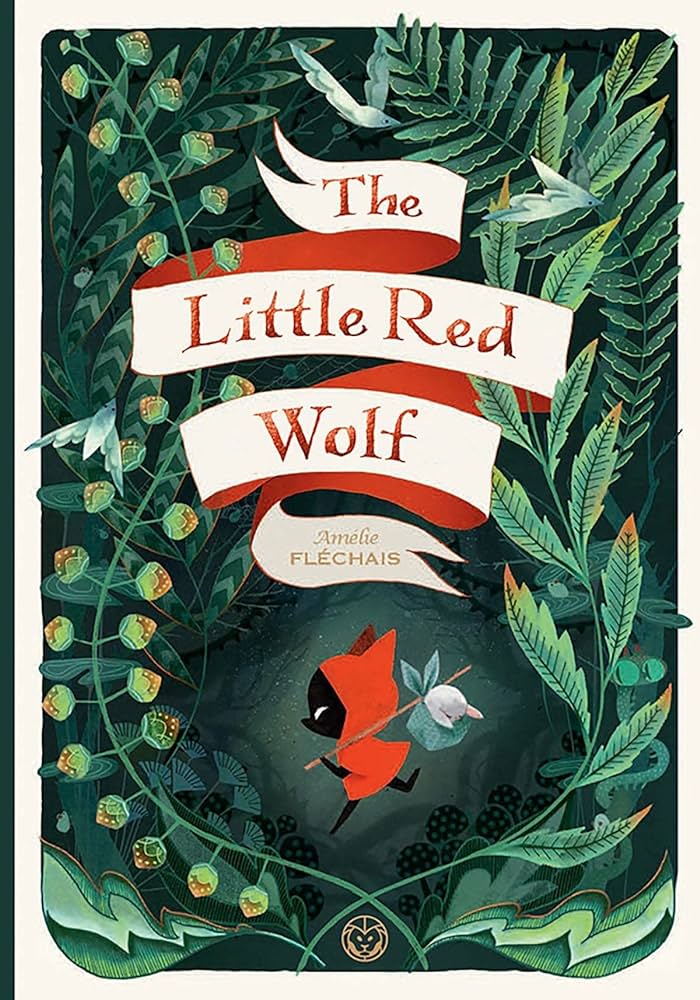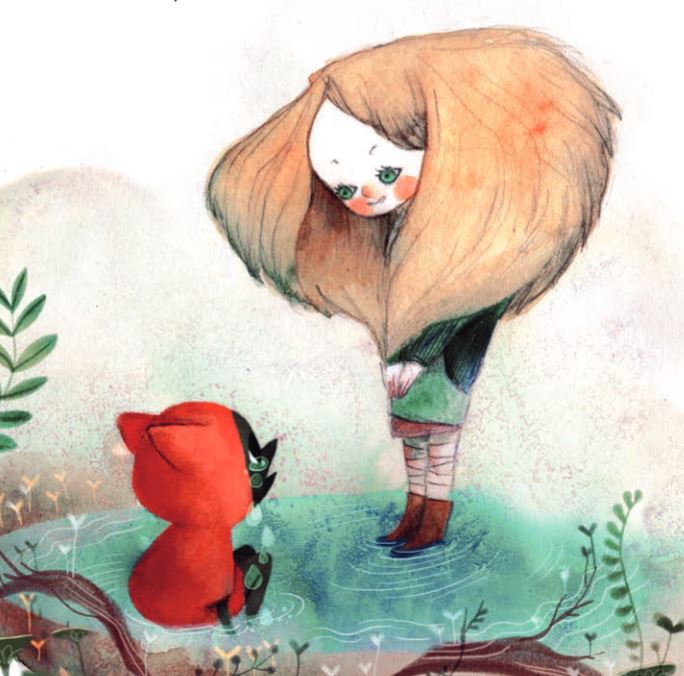
(Author’s note: I received a digital copy of today’s subject from the publisher through NetGalley in exchange for an honest review.)
Folklore is a funny, maze-like topic. A single tale can have many different versions, and a legend changes depending on who, or where, you ask. As a Witch, I find it fascinating to compare the different varieties a single story can have, learn from the symbolism behind those variations, and see what they can say about the people, time, and place they come from.

The cover to “The Little Red Wolf” by Amélie Fléchais [Oni Press]
That’s the main reason why I found The Little Red Wolf by Amélie Fléchais, a French illustrator and painter who has worked with DreamWorksanimation, so captivating.
An enchanting retelling of the Charles Perrault classic tale Little Red Riding Hood.
Once upon a time there was a little red wolf who lived in a treehouse in a thick and mysterious forest. The young wolf sets out on a journey to bring his grandmother a rabbit when he is charmed by a nice little girl who offers to help him. But nice is not the same as good.
-Description of The Little Red Wolf from the publisher
Retellings are nothing new. A few years ago, they were everywhere and anywhere, from movies to TV series to video games, and don’t get me started with books! However, The Little Red Wolf is particular in a way that I found fascinating. It follows the simple, innocent structure of the original tale, with no added elements or overdone plots, but explores the influence of folklore and, potentially, folk beliefs.
Both the wolves and the little girl know different versions of the same myth, and they apply it in different ways, shaping their views of the world, the decisions they make, and even who they are – the roles they play in particular. Their beliefs shape them to a deep level, and we have no clue as to who knows the right version of the story, if any of them. I find it interesting that both versions are passed down orally through the families of wolves and humans, and they don’t know the other’s version, which makes them each extremists in their own points of view.
As a Witch, I have always tried to find the original version of whichever myth I was interested in: who was Medusa? Did Hera really hate Hercules? What happened between Seth and Horus? Where does the tale of Snow White come from? It is a never ending quest, because every time I think I have found the ur–myth, there is another one that seems to be related.
This is a book that shows us that stories change over time, and that while we could try to trace their origins, it most likely would be in vain (with a few exceptions, like the most accurate version of the Arabian Nights, based on the original manuscripts). It’s the meaning behind the stories that actually matters. We can see how the humans’ version drives them to be violent, and how the wolves seem to be more civilized; it doesn’t mean that the humans are wrong, but that they’re using their traditions to do harm, something I find very close to blasphemy.

An illustration from “The Little Red Wolf” by Amélie Fléchais [Oni Press]
Myths, legend, and folklore are tricky. I’ve seen different versions of Rapunzel, some more graphic than the other, and the Scottish ballads of Tam Lin and Thomas the Rhymer also have different versions. However, the small details that change depending on which version we’re reading says a lot about the people of that time and place. It also offers new symbology, new meanings, different perspectives, and a broader field of inspiration for practice.
For example: the first record of a tale similar to Rapunzel is Petrosinella, which has strong feminist themes, and shows the couple escaping from the ogress, while the Grimms’ version has them separated and scarred, to be later reunited, with the prince having more agency and guiding Rapunzel towards her freedom.
The Little Red Wolf is a story that reminds me of this: that stories change, that people change, and while we need to respect and keep our traditions and culture alive, it doesn’t mean they can be an excuse for harm or put others in danger. This easily reminds me of the different traditions and branches that we can find in Paganism, and how some may try to say that they have the best approach.
As a simple, quick reading, I enjoyed it and would love to have a printed version. It’s a book I see myself reading to my kids in the future, talking with them and sharing our thoughts, but also making sure that they understand what I just said: stories are what we make of them. Symbolism changes depending on who you ask, and when, and where.
As a Pagan and a Witch, this reminds me of how unpredictable folklore can be, how seemingly insignificant changes could represent a big change in the story, and how their messages could be just as delicate. That doesn’t mean we have to be afraid of them, just that we should be cautious. We don’t know if there’s an evil wolf or the daughter of a hunter hidden in those forests, after all.
- Publisher: Oni Press (October 17, 2023)
- Publication date: October 17, 2023.
- Reading age: 4 – 8 years.
- Genres: Fantasy, children’s literature, graphic novels and comics.
- Print length: Paperback, 80 pages.
The Wild Hunt is not responsible for links to external content.
To join a conversation on this post:
Visit our The Wild Hunt subreddit! Point your favorite browser to https://www.reddit.com/r/The_Wild_Hunt_News/, then click “JOIN”. Make sure to click the bell, too, to be notified of new articles posted to our subreddit.